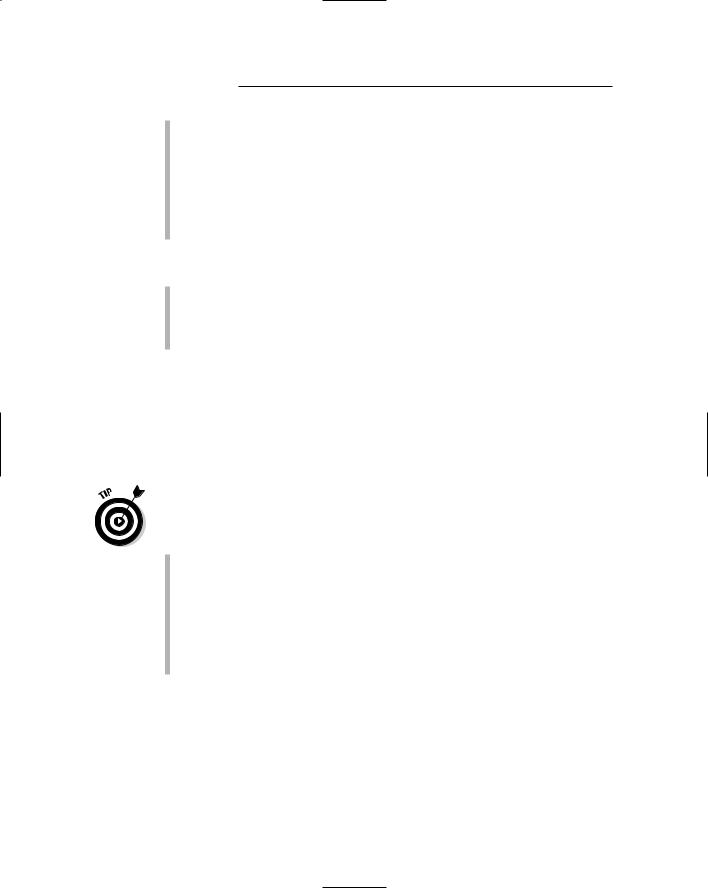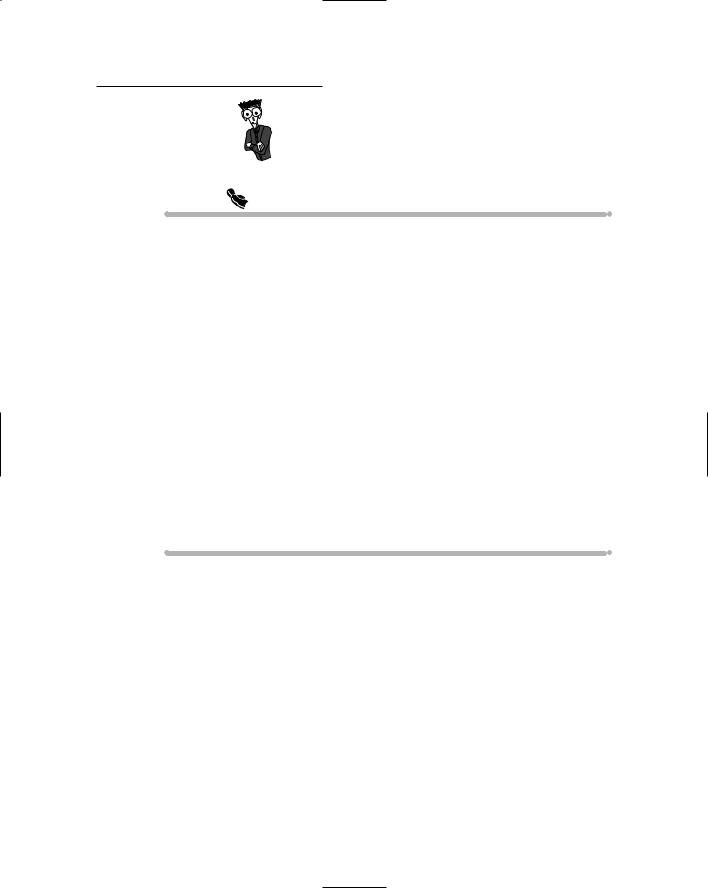
Russian For Dummies
.pdf
24 |
Part I: Getting Started |
B is pronounced like p.
V is pronounced like f.
G is pronounced like k.
D is pronounced like t.
Zh is pronounced like sh.
Z is pronounced like s.
Here are some examples:
You write Smirnov but pronounce it as smeer-nohf because v at the end of the word is pronounced like f.
You write garazh (garage) but say guh-rahsh, because at the end of the word, zh loses its voice and is pronounced like sh.
Nutty clusters: Pronouncing consonant combinations
Russian speech often sounds like an endless flow of consonant clusters. Combinations of two, three, and even four consonants are quite common. Take, for example, the common word for hello in Russian — zdravstvujtye (zdrah-stvooy-tee), which has two difficult consonant combinations (zdr and vstv). Or take the word for opinion in Russian — vzglyad (vzglyat). The word contains four consonants following one another: vzgl.
How in the world do Russians say these words without choking? They practice, and so should you. Here are some words that contain consonant clusters you may want to repeat at leisure:
obstoyatyel’stvo (uhp-stah-ya-teel’-stvuh; circumstance)
pozdravlyat’ (puh-zdruhv-lyat’; to congratulate)
prestuplyeniye (pree-stoo-plyen-ee-ye; crime)
Rozhdyestvo (ruzh-deest-voh; Christmas)
vzdor (vzdohr; nonsense)
vzglyanut’ (vzglee-noot’; to look/glance)
Surveying sticky sounds
Some Russian letters and sounds are hard for speakers of English. Take a look at some of them and find out how to pronounce them.

Chapter 1: You Already Know a Little Russian 25
The bug sound zh
This sound corresponds to the letter Ææ. It looks kind of like a bug, doesn’t it? It sounds like a bug, too! In pronouncing it, try to imitate the noise produced by a bug flying over your ear — zh-zh-zh . . . The sound is similar to the sound in the words “pleasure” or “measure.”
The very short i sound
This sound corresponds to the letter Jj. This letter’s name is i kratkoye, which literally means “a very short i,” but it actually sounds like the very short English y. This sound is what you hear when you say the word boy. You should notice your tongue touching the roof of your mouth when you say this sound.
The rolled sound r
This sound corresponds to the letter Rr in the Russian alphabet. To say it correctly, begin by saying an English r and notice that your tongue is rolled back. Now begin moving your tongue back, closer to your upper teeth and try to say this sound with your tongue in this new position. You’ll hear how the quality of the sound changes. This is the way the Russians say it.
The guttural sound kh
The corresponding Russian letter is Xx. To say it, imagine that you’re eating and a piece of food just got stuck in your throat. What’s the first reflex you body responds with? Correct! You will try to cough it up. Remember the sound your throat produces? This is the Russian sound kh. It’s similar to the German ch.
The revolting sound y
To say this sound correctly, imagine that you’re watching something really revolting, like an episode from Fear Factor, where the participants are gorging on a plate of swarming bugs. Now recall the sound you make in response to this. This sound is pronounced something like ih, and that’s how you pronounce the Russian y (the transliteration is y). Because this letter appears in some of the most commonly used words, including ty (tih; you; informal), vy (vih; you; formal singular and plural), and my (mih; we), it’s important to say it as best you can.
The hard sign
This is the letter =. While the soft sign makes the preceding sound soft (see the next section), the hard sign makes it — yes, you guessed it — hard. The good news is that this letter (which transliterates to ”) is rarely ever used in contemporary Russian. And even when it is, it doesn’t change the pronunciation of the word. So, why does Russian have this sign? For two purposes:
To harden the previous consonant
To retain the hardness of the consonant before the vowels ye, yo, yu, and ya

26 |
Part I: Getting Started |
Without the hard sign, these consonants would normally palatalize (or soften). When a hard sign = separates a consonant and one of these vowels, the consonant is pronounced without palatalization, as in the word pod”yezd (pahd-yezd; porch), for example. However, don’t worry too much about this one if your native language is English. Native speakers of English rarely tend to palatalize their Russian consonants the way Russians do it. In other words, if you’re a native English speaker and you come across the situation described here, you probably make your consonant hard and therefore pronounce it correctly by default!
The soft sign
This is the letter ; (transliterated to ’), and it doesn’t have a sound. Its only mission in life is to make the preceding consonant soft. This sound is very important in Russian because it can change the meaning of a word. For example, without the soft sign, the word mat’ (maht’; mother) becomes mat, which means “obscene language.” And when you add a soft sign at the end of the word von (vohn; over there), it becomes von’ (vohn’) and means “stench.” See how important the soft sign is?
So, here’s how you can make consonants soft:
1.Say the consonant — for example, l, t, or d. Note where your tongue is. What you should feel is that the tip of your tongue is touching the ridge of your upper teeth and the rest of the tongue is hanging in the mouth like a hammock in the garden on a nice summer day.
2.While you’re still pronouncing the consonant, raise the body of your tongue and press it against the hard palate. Can you hear how the quality of the consonant has changed? It sounds much “softer” now, doesn’t it? That’s how you make your consonants soft.
Using Popular Expressions
Using popular expressions is one way to make a great first impression when speaking Russian. We recommend that you memorize the phrases in the following sections because they can come in handy in almost any situation.

Chapter 1: You Already Know a Little Russian 27
Speaking courteously
The way to say “please” and “you’re welcome” in Russian is pozhalujsta (pah- zhahl-stuh). You often use the word pozhalujsta just after the verb when making a polite request, as in the following sentences:
Povtoritye, pozhalujsta. (puhf-tah-ree-tee pah-zhahl-stuh; Please repeat what you said.)
Govoritye, pozhalujsta, pomyedlyennyeye. (guh-vah-ree-tee pah-zhahl- stuh pah-myed-lye-nee-ee; Please speak a little more slowly.)
Skazhitye, pozhalujsta, kak proiti do myetro? (skah-zhih-tee pah-zhahl- stuh kahk prahy-tee duh meet-roh; Please tell me how to get to the subway station.)
After somebody answers your polite request or does you a favor, you say spasibo (spuh-see-buh; thank you) or spasibo bol’shoye (spuh-see-buh bahl’- shoy-ee; thank you very much).
When you want to say “you’re welcome,” you simply use the word pozhalujsta by itself.
Excusing yourself
The most common way to say “excuse me” in Russian is izvinitye (eez-vee- nee-tee). To be even more polite, you can add the word pozhalujsta (pah- zhahl-stuh; please), as in the following sentences:
Izvinitye, pozhalujsta, mnye pora. (eez-vee-nee-tee pah-zhahl-stuh mnye pah-rah; Excuse me, it’s time for me to go.)
Izvinitye, pozhalujsta, ya vas nye ponimayu. (eez-vee-nee-tee pah- zhahl-stuh yah vahs nee puh-nee-mah-yu; Excuse me, I didn’t understand what you said.)
Arming yourself with other handy phrases
You can also put the following phrases to good use in Russian:
Dobro pozhalovat’! (dahb-roh pah-zhah-luh-vuht’; Welcome!)
Pozdravlyayu vas! (puhz-druhv-la-yu vahs; Congratulations!)

28 |
Part I: Getting Started |
Zhyelayu udachi! (zhih-lah-yu oo-dah-chee; Good luck!)
Nichyego. (nee-chee-voh; It’s all right/no problem.)
Vsyego khoroshyego! (vsee-voh khah-roh-shih-vuh; All the best!)
Priyatnogo appyetita! (pree-yat-nuh-vuh uh-pee-tee-tuh; Bon appetit!)
Zhal’! (zhahl’; Too bad!)
Khorosho. (khuh-rah-shoh; It’s all right.)
Reading Russian with Ease
Reading in Russian is an important skill to have. If you want to read a Russian magazine, menu, or train schedule, or if you want find your way around Russian-speaking places, you have to know how to read some Russian.
Suppose that you’re walking in the Russian district of an American city and are suddenly in the mood for food. Being able to read Russian is a big help when you see a building with the sign PECTOPAH (ree-stah-rahn) on it. You’ll understand that the building is exactly what you’re looking for — a restaurant! (We give you the lowdown on talking about food in Chapter 5.)
Or imagine that you booked a trip to Moscow with your favorite travel agent and you’ve just gotten off the plane. The big sign on the airport building reads Sa√kt-Peterbrg. If you know how to read some Russian, you’re able to understand that the sign says Sankt-Peterburg (sahnk pee-teer-boork;
St. Petersburg) and not Moskva/Moskva (mahs-kvah; Moscow), which means you’ve come to the wrong place, and it’s time to find a new travel agent! (You can find out all about planning a trip to Russia and navigating the airport in Chapters 11 and 12.)
The first step to reading Russian is recognizing Cyrillic letters (see “From A to Ya: Making sense of Cyrillic,” earlier in this chapter, for info on these letters). Try sounding out each word, and you may be surprised that you recognize quite a few of them because they’re similar to words you know in English or other languages. Then you can look up the ones you’re unsure of in the Russian-English dictionary. You don’t need to know every word in a sentence to get the sense of what you’re reading. At least try to locate and understand the nouns and the verbs, and you’ll be off to a good start (see Chapter 2 for info on nouns and verbs).

Chapter 1: You Already Know a Little Russian 29
 Fun & Games
Fun & Games
Match the Russian letters in the first column with the sounds they correspond to in the second column. You can find the answers in Appendix C.
1. N |
a. r |
|
2. |
R |
b. n |
3. |
G |
c. ee |
4. |
Q |
d. ya |
5. |
I |
e. g |
Below are Russian cognates used in English. Sound out each word and see whether you can recognize its meaning. The answers are in Appendix C.
1.Vodka
2.Bor]
3.Perestrojka
4.Glasnost;
5.Sputnik
6.Car;

30 |
Part I: Getting Started |

Chapter 2
The Nitty Gritty: Basic Russian
Grammar and Numbers
In This Chapter
Understanding the Russian case system
Using nouns, pronouns, and adjectives
Forming verbs in different tenses
Discovering Russian adverbs
Creating Russian-sounding sentences
Counting and using numbers in Russian
Grammar is the glue that ties together all the words in a sentence in any language. Not knowing grammar can be very frustrating and sometimes
even embarrassing, so getting the basics of Russian grammar down is worth your time. Russian has more grammar than English does, but fortunately it’s all very structured, and you can easily learn it if you put in a little effort.
You may be surprised to find out that English and Russian are very distant relatives. Both come from the same ancestor — Sanskrit — and both belong to the same family of Indo-European languages. Although they’re distantly related, they have one big difference: Unlike English, Russian is a flectional language, which is a fancy way of saying that it has lots of different word endings.
English words don’t have too many different flections, or endings. As far as verbs go, you have the -ed ending for past tense verbs (worked) and the -ing ending for some present tense verbs (working). And you also know the singular present verb form -(e)s (goes, walks), and the -er and -est endings for comparative and superlative adjectives (bigger, biggest). And singular nouns don’t have any flections at all. A table is a table is a table, no matter how you use it in a sentence.
But in Russian, the same noun can take several different endings! The ending depends on the case of the noun, which is determined by how the noun is

32 |
Part I: Getting Started |
used in the sentence. And a Russian verb in the present tense can take up to six different endings, depending on who the subject of the sentence is.
In this chapter, you find out about cases and the different noun and verb endings. You discover how to spice up your speech with pronouns, adjectives, and adverbs. You also find out how to ask questions and how to form other complete sentences that make you sound like a real Russian. As a bonus, you also discover how to count in Russian and use numbers with nouns.
Making the Russian Cases
In a Russian sentence, every noun, pronoun, and adjective takes a different ending depending on the case it’s in. What’s a case? In simple terms, cases are sets of endings that words take to indicate their function and relationship to other words in the sentence. If you’ve studied languages such as Latin or German, you know that different languages have different numbers of cases. Russian has six cases, which isn’t that bad compared to Finnish, which has fifteen! English speakers, on the other hand, never have to bother with cases.
In the following sections, you discover the six different cases in Russian and how to use them. (Later in this chapter, we explain the specific endings that nouns, pronouns, and adjectives take in each case.)
Nominative case
A noun (or a pronoun or an adjective) always appears in the nominative case in an English-Russian dictionary. Its main function is to indicate the subject of the sentence.
As a rule, the subject behaves the same way in Russian as it does in English. It answers the question “Who or what is performing the action?”
For example, in the sentence Bryenda izuchayet russkij yazyk (brehn-duh ee-zoo-chah-eet roos-keey ee-zihk; Brenda studies Russian), the word Bryenda, indicating a woman who (like yourself) studies Russian, is the subject of the sentence and consequently is used in the nominative case.
Genitive case
You usually use the genitive case to indicate possession. It answers the question “Whose?” In the phrase kniga Anny (knee-guh ah-nih; Anna’s book), Anna is in the genitive case (Anny) because she’s the book’s owner.

Chapter 2: The Nitty Gritty: Basic Russian Grammar and Numbers |
33 |
Genitive case also is used to indicate an absence of somebody or something when you combine it with the word nyet (nyet; no/not), as in Zdyes’ nyet knigi (zdyes’ nyet knee-gee; There’s no book here). Knigi (knee-gee; book) is in the genitive case because the book’s absence is at issue.
Russian uses genitive case after many common prepositions, such as okolo (oh-kuh-luh; near), u (oo; by, by the side of), mimo (mee-muh; past), iz (ees; out of), vmyesto (vmyes-tuh; instead of), and byez (byes; without). For more info on prepositions, see Chapter 15.
Accusative case
The accusative case mainly indicates a direct object, which is the object of the action of the verb in a sentence. For example, in the sentence Ya lyublyu russkij yazyk (yah lyu-blyu roo-skeey ee-zihk; I love Russian), the phrase russkij yazyk is in the accusative case because it’s the direct object.
Some frequently used verbs like chitat’ (chee-taht’; to read) vidyet’ (vee- deet’; to see), slushat’ (sloo-shuht’; to hear), and izuchat’ (ee-zoo-chaht’; to study) take the accusative case. Like in English, these verbs always take direct objects.
The accusative case is also required in sentences containing verbs of motion, which indicate destination of movement. For instance, if you want to announce to your family that you’re going to Rossiya (rah-see-ye; Russia), Rossiya takes the form of the accusative case, which is Rossiyu (rah-see-yu; Russia). Chapter 12 is full of info on verbs of motion.
You also use the accusative case after certain prepositions, such as pro (proh; about) and chyeryez (chye-rees; through).
Dative case
Use the dative case to indicate an indirect object, which is the person or thing toward whom the action in a sentence is directed. For example, in the sentence Ya dal uchityelyu sochinyeniye (yah dahl oo-chee-tee-lyu suh-chee- nye-nee-ee; I gave the teacher my essay), uchityelyu (oo-chee-tee-lyu; teacher) is in the dative case because it’s the indirect object. (“My essay” acts as the direct object, which we cover in the previous section.)
You also use the dative case after certain prepositions such as k (k; toward) and po (poh; along).
